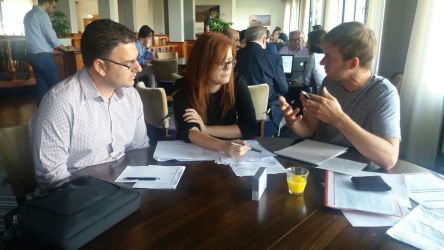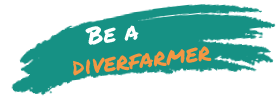The research team of the Diverfarming project, financed by the European Commission, agrees on a common methodology to evaluate the environmental and socioeconomic impact of the combination of crops as opposed to monocropping practices with high inputs.
Europe continues to drive the first scientificassessment works on agricultural practices based on crop biodiversity. This has been done thanks to the Diverfarming project, whose scientific team, led by Raúl Zornozafrom the Universidad Politécnica de Cartagena, reached a consensus last week inAmeland (Netherlands) on the methodologies and criteria that will serve to answer the big question: is it really profitable to combine crops on the same land, whether it be by rotations or by means of simultaneous crops at the time?
 The first socioeconomic approach carried out by the Diverfarming team under the coordination of Heike Lehtonenfrom Luke (Finland) confirms that monocropping continues to be considerably more popular throughout Europe, despite it being less economically and environmentally efficient than the combination of crops, if analysed in the long term. In fact, as Lehtonenexplained in the presentation of the first results, monocrops are less resistant to abrupt variations in the climate such as drought periods or flooding. Moreover, they do not allow synergies to be harnessed and those who practice monocropping are at a greater market risk. To demonstrate this, the Diverfarming team will carry out a detailed study of the social and economic impact of agricultural diversification, addressing the value chain, that is to say from the field to the table. Therefore, the team contains a considerable group of experts in the agrarian economy led by Stefano Pascucci, researcher from the University of Exeter, who took the opportunity given by the annual meeting of Diverfarming held in Ameland to present the concrete parameters that will be measured in the 14 Diverfarming case studies. These trials have been selected over the last year’s work thanks to a participative process that has counted on the experiences and prior knowledge of the actual farmers, agricultural technicians, administrations and researchers from the six countries in which diversification will be assessed: Spain, Italy, The Netherlands, Finland, Hungary and Germany. A habitual procedure in citizen science projects which on this occasion has been coordinated by Javier Calatrava and María Dolores Gómez-López from the Universidad Politécnica de Cartagena. In this way, the practices and management that the implicated agents consider will be most effective to improve agricultural profitability have been assessed, to put them to test and to assess them from different perspectives throughout the four remaining years of the project.
The first socioeconomic approach carried out by the Diverfarming team under the coordination of Heike Lehtonenfrom Luke (Finland) confirms that monocropping continues to be considerably more popular throughout Europe, despite it being less economically and environmentally efficient than the combination of crops, if analysed in the long term. In fact, as Lehtonenexplained in the presentation of the first results, monocrops are less resistant to abrupt variations in the climate such as drought periods or flooding. Moreover, they do not allow synergies to be harnessed and those who practice monocropping are at a greater market risk. To demonstrate this, the Diverfarming team will carry out a detailed study of the social and economic impact of agricultural diversification, addressing the value chain, that is to say from the field to the table. Therefore, the team contains a considerable group of experts in the agrarian economy led by Stefano Pascucci, researcher from the University of Exeter, who took the opportunity given by the annual meeting of Diverfarming held in Ameland to present the concrete parameters that will be measured in the 14 Diverfarming case studies. These trials have been selected over the last year’s work thanks to a participative process that has counted on the experiences and prior knowledge of the actual farmers, agricultural technicians, administrations and researchers from the six countries in which diversification will be assessed: Spain, Italy, The Netherlands, Finland, Hungary and Germany. A habitual procedure in citizen science projects which on this occasion has been coordinated by Javier Calatrava and María Dolores Gómez-López from the Universidad Politécnica de Cartagena. In this way, the practices and management that the implicated agents consider will be most effective to improve agricultural profitability have been assessed, to put them to test and to assess them from different perspectives throughout the four remaining years of the project.
Additionally, as well as the social and economic assessment, this year the studies on biodiversity and environmental impact will begin, once the parameters to take into account have been agreed upon. Under the coordination of Sören Thiele-Bruhm from the University of Trier (Germany) and Dénes Loczy from the University of Pécs (Hungary),analysis will be performed on how the biodiversity in soils increases and the incidence of pests and diseases is reduced, measuring the microbial and invertebrate structure and the presence of diseases or pests transmitted by the soil, among other aspects. To this end, Diverfarming has designed its own methodology which unifies soil sampling and analysis systems in the different regions so that the same indicators are assessed and thus conclusions can be extrapolated. The environmental impact will be measured according to variables that take into account the climatic conditions of the different areas and the parameters that really offer measures that can be evaluated from the environmental point of view. In this way, the handling of low inputs will be evaluated reduction in the use of machinery, phytosanitary products, fertilisers, manures or water) and their influence on the improvement of water resources, carbon sequestration or fertility of the soils.
All the data generated from the already unified measurements will serve for the design of mathematical models that enable predictions of profitability and efficacy to be made, as the researcher Roberta Farina of the Council for Agricultural Research and Analysis of the Agrarian Economy in Italyexplained.
Diverfarming is a project financed by the Horizon 2020 Programme of the European Commission, within the challenge of “Food Security, Sustainable Agriculture and Forestry, Marine, Maritime and Inland Water Research and the Bioeconomy”, which counts on the participation of the Universities of Cartagena and Córdoba (Spain), Tuscia (Italy), Exeter and Portsmouth (United Kingdom), Wageningen (Netherlands), Trier (Germany), Pécs (Hungary) and ETH Zurich (Switzerland), the research centres Consiglio per la ricerca in agricoltura el'analisi del l'economia agraria (Italy), the Consejo Superior de Investigaciones Científicas (Spain) and the Natural Resources Institute LUKE (Finland), the agrarian organisation ASAJA, and the companies Casalasco and Barilla (Italy), Arento, Disfrimur logística and Industria David (Spain), Nieuw Bromo Van Tilburg and Ekoboerdeij de Lingehof (Netherlands), Weingut Dr. Frey (Germany), Nedel-Market KFT and Gere (Hungary) and Paavolan Kotijuustola and Polven Juustola (Finland).










